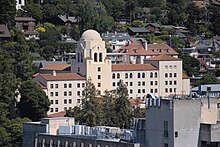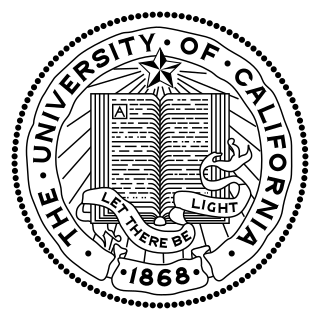
The University of California (UC) is a public land-grant research university system in the U.S. state of California. Headquartered in Oakland, the system is composed of its ten campuses at Berkeley, Davis, Irvine, Los Angeles, Merced, Riverside, San Diego, San Francisco, Santa Barbara, and Santa Cruz, along with numerous research centers and academic abroad centers. The system is the state's land-grant university. Major publications generally rank most UC campuses as being among the best universities in the world. In 1900, UC was one of the founders of the Association of American Universities and since the 1970s seven of its campuses, in addition to Berkeley, have been admitted to the association. Berkeley, Davis, Santa Cruz, Irvine, Los Angeles, Santa Barbara, and San Diego are considered Public Ivies, making California the state with the most universities in the nation to hold the title. UC campuses have large numbers of distinguished faculty in almost every academic discipline, with UC faculty and researchers having won 71 Nobel Prizes as of 2021.

Arthur Brown Jr. (1874–1957) was an American architect, based in San Francisco and designer of many of its landmarks. He is known for his work with John Bakewell Jr. as Bakewell and Brown, along with later works after the partnership dissolved in 1927.

Bowles Hall is a coed residential college at the University of California, Berkeley, known for its unique traditions, parties, and camaraderie. Designed by George W. Kelham, the building was the first residence hall on campus, dedicated in 1929, and was California's first state-owned residence hall. It was built in 1928 with a $350,000 grant from Mary McNear Bowles in memory of her husband, Berkeley alumnus and University of California Regent Phillip E. Bowles. Mr. Bowles was said to have three loves: horses, horticulture and the University of California.

The California College of the Arts (CCA) is a private art school in San Francisco, California. It was founded in Berkeley, California in 1907 and moved to a historic estate in Oakland, California in 1922. In 1996, it opened a second campus in San Francisco; in 2022, the Oakland campus was closed and merged into the San Francisco campus. CCA enrolls approximately 1,239 undergraduates and 380 graduate students.

The University House is a residence and venue for official events on the campus of the University of California, Berkeley. Designed by the architect Albert Pissis and completed in 1911, it was formerly named President's House while it served as the home of the president of the University of California, starting with Benjamin Ide Wheeler and ending with Robert Gordon Sproul. Since 1965, it has been the home of the Chancellor of the Berkeley campus.
The Berkeley Student Cooperative (BSC) is a student housing cooperative serving primarily UC Berkeley students, but open to any full-time post-secondary student. The BSC houses and/or feeds over 1,300 students in 17 houses and three apartment buildings. Food is provided to residents of the 17 houses, which also offer boarding meal plans to non-residents. As part of their rental agreement, residents of the houses are required to perform workshifts, typically five hours per week. The BSC is led by a board of directors which is primarily composed of and elected by student members.

Oakland Technical High School, known locally as Oakland Tech or simply "Tech", is a public high school in Oakland, California, United States, and is operated under the jurisdiction of the Oakland Unified School District. It is one of six comprehensive public high school campuses in Oakland. Oakland Tech's attendance jurisdiction includes several neighborhoods, including Oakland Chinatown, Rockridge, North Oakland, and Temescal.
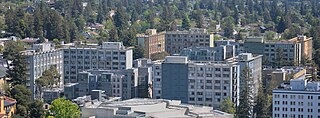
Housing at the University of California, Berkeley, includes student housing facilities run by the office of Residential and Student Service Programs (RSSP). Housing is also offered by off-campus entities such as fraternities and sororities and the Berkeley Student Cooperative (BSC).
Oakland City Center is an office, shopping and hotel complex in Downtown Oakland, Oakland, California. The complex is the product of a redevelopment project begun in the late 1950s. It covers twelve city blocks between Broadway on the east, Martin Luther King Jr. Way on the west, Frank H. Ogawa Plaza on 14th Street on the north side of the complex and the Oakland Convention Center and Marriott Hotel extend south to 10th Street. An hourly parking garage is located beneath the complex's shopping mall. The mall features an upscale fitness and racquet club, in addition to numerous take-out restaurants and other stores. The complex is served by the 12th Street/Oakland City Center BART station.

William Wilson Wurster was an American architect and architectural teacher at the University of California, Berkeley, and at the Massachusetts Institute of Technology, best known for his residential designs in California.
The campus of the University of California, Berkeley, and its surrounding community are home to a number of notable buildings by early 20th-century campus architect John Galen Howard, his peer Bernard Maybeck, and their colleague Julia Morgan. Subsequent tenures as supervising architect held by George W. Kelham and Arthur Brown, Jr. saw the addition of several buildings in neoclassical and other revival styles, while the building boom after World War II introduced modernist buildings by architects such as Vernon DeMars, Joseph Esherick, John Carl Warnecke, Gardner Dailey, Anshen & Allen, and Skidmore, Owings and Merrill. Recent decades have seen additions including the postmodernist Haas School of Business by Charles Willard Moore, Soda Hall by Edward Larrabee Barnes, and the East Asian Library by Tod Williams Billie Tsien Architects.

International House New York, also known as I-House, is a private, independent, non-profit residence and program center for postgraduate students, research scholars, trainees, and interns, located at 500 Riverside Drive in Morningside Heights, Manhattan, New York City.

UC Village, also called University Village or University Village Albany, is a housing community for students and postdocs who are married or have dependents. It is owned and administered by the University of California, Berkeley. It is located within the city limits of Albany about two miles away from the main Berkeley campus, at an elevation of 26 feet. It was originally known as Codornices Village, and later, Albany Village. It is also commonly referred to as The Village.
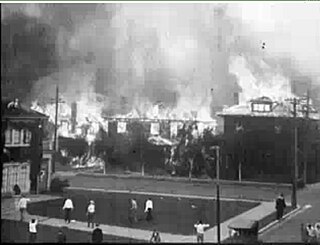
The 1923 Berkeley, California, fire was a conflagration that consumed some 640 structures, including 584 houses in the densely built neighborhoods north of the campus of the University of California in Berkeley, California, on September 17, 1923.

Ernest Born (1898−1992) was an architect, designer, and artist based in California. He and his wife Esther Baum Born (1902−1987) collaborated on diverse projects in the San Francisco Bay Area from 1936 on. She was also a notable architectural photographer.
Edwards Stadium is the track and field and soccer venue for the California Golden Bears, the athletic teams of the University of California, Berkeley. It has been a Berkeley Landmark since November 2, 1992, under the name Edwards Stadium and Field.
Clarence William Whitehead Mayhew was an American architect best known as a designer of residential structures in the San Francisco Bay Area. Recognition came to him with a home designed in 1937 for the Manor family in Orinda, California; one which was included as an example of modern architecture's effect on the contemporary ranch house in California in several post-war published compilations of residential works.
The history of the University of California, Berkeley begins on October 13, 1849, with the adoption of the Constitution of California, which provided for the creation of a public university. On Charter Day, March 23, 1868, the signing of the Organic Act established the University of California, with the new institution inheriting the land and facilities of the private College of California and the federal funding eligibility of a public agricultural, mining, and mechanical arts college.
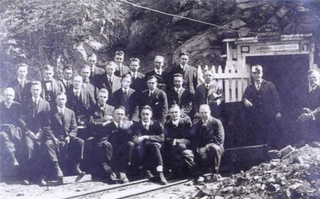
The Lawson Adit is a horizontal mine tunnel, or adit, on the UC Berkeley campus, near the Hearst Mining Building, dug directly through the Hayward Fault. Started in 1916, the adit is named after Andrew Lawson, one-time Dean of the College of Mining at UC Berkeley.

The University of California, Berkeley, Extension is the continuing education division of the University of California, Berkeley campus. Founded in 1891, UC Berkeley Extension provides continuing education through self-supporting academic programs.
